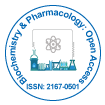
Biochemistry & Pharmacology: Open Access
Open Access
ISSN: 2167-0501
+44-77-2385-9429

ISSN: 2167-0501
+44-77-2385-9429
Perspective - (2024)Volume 13, Issue 3
Peptide bonds are fundamental links in the structure of proteins, formed through a biochemical reaction that involves the joining of two amino acids. The process of peptide bond formation and hydrolysis is important for various biological functions, including protein synthesis, degradation, and cellular signaling. The formation of a peptide bond begins with the interaction between the amino group of one amino acid and the carboxyl group of another. This reaction is a type of condensation reaction, where a molecule of water is released as a byproduct. Specifically, the amino group of one amino acid, which has the general formula – NH2, reacts with the carboxyl group of another amino acid, which has the general formula –COOH. In this reaction, the hydroxyl group (–OH) from the carboxyl group and a hydrogen atom (–H) from the amino group combine to form a water molecule (H2O). The remaining parts of the two amino acids link together through a covalent bond, resulting in a peptide bond. This bond connects the carbonyl carbon of one amino acid to the nitrogen of the next, forming the backbone of the polypeptide chain.
The peptide bond itself is a type of amide bond, characterized by a planar structure due to the partial double-bond character between the carbonyl carbon and the nitrogen atom. This partial double-bond character arises from the resonance between the carbonyl group and the amide group, which restricts the rotation around the peptide bond. Consequently, the peptide bond adopts a trans configuration in most cases, where the alpha carbons of the two adjacent amino acids are on opposite sides of the peptide bond, contributing to the stability and predictability of protein structures. Hydrolysis of peptide bonds is the reverse process, where the bond between two amino acids is broken through the addition of water. This reaction is need for protein degradation and recycling within the cell. In hydrolysis, a water molecule interacts with the peptide bond, leading to the cleavage of the bond. The water molecule provides a hydroxyl group and a hydrogen atom, which are incorporated into the products of the reaction. Specifically, the hydroxyl group attaches to the carbonyl carbon, forming a carboxyl group on one of the products, while the hydrogen atom attaches to the nitrogen, forming an amino group on the other product. This reaction results in the formation of two separate amino acids from the original peptide.
The hydrolysis of peptide bonds can be catalyzed by enzymes known as proteases or peptidases, which facilitate the breakdown of proteins into their constituent amino acids. These enzymes play an important role in various physiological processes, such as digestion, where dietary proteins are broken down into amino acids that can be absorbed and utilized by the body. Proteases can be classified into different types based on their mechanism of action, including serine proteases, cysteine proteases, and metalloproteases, each utilizing different active site residues and metal cofactors to catalyze peptide bond cleavage. The hydrolysis reaction can also be carried out under acidic or basic conditions, though these methods are less specific than enzymatic hydrolysis. Acidic hydrolysis involves the use of strong acids, such as hydrochloric acid, which protonate the carbonyl oxygen of the peptide bond, making it more susceptible to nucleophilic attack by water. Basic hydrolysis, or alkaline hydrolysis, involves the use of strong bases, such as sodium hydroxide, which deprotonate the amino group, facilitating the cleavage of the peptide bond. Both methods result in the breakdown of the peptide bond and the release of free amino acids.
Citation: Leone M (2024). Peptide Bond Hydrolysis: Enzymatic and Non-Enzymatic Pathways in Protein Metabolism. Biochem Pharmacol.13:375.
Received: 19-Aug-2024, Manuscript No. BCPC-24-34104; Editor assigned: 22-Aug-2024, Pre QC No. BCPC-24-34104 (PQ); Reviewed: 06-Sep-2024, QC No. BCPC-24-34104; Revised: 13-Sep-2024, Manuscript No. BCPC-24-34104 (R); Published: 20-Sep-2024 , DOI: 10.35248/2167-0501.24.13.375
Copyright: © 2024 Leone M. This is an open-access article distributed under the terms of the Creative Commons Attribution License, which permits unrestricted use, distribution, and reproduction in any medium, provided the original author and source are credited.